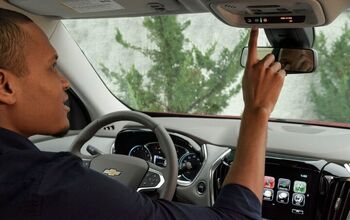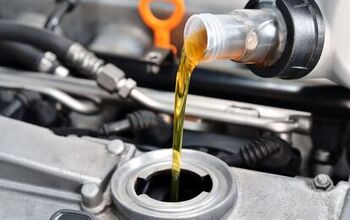The Big Apple's Rules of the Road
New York City boasts the highest concentration of gargantuan rear wheel drive V8-powered cars in the country, 99% of which sit on Ford’s Panther platform. Still, in layout and public transit it may be the most European city in the U.S. But there’s nothing European about the way people drive in the city’s five boroughs. It’s like the Matrix – you can’t really be told what it is, you have to see it for yourself to understand. Let’s start with the rules.
Forget everything you know about driving. There are only three rules for driving in New York. First, don’t block the box. Second, no Lena horn. And third, don’t hit anyone or anything.
Almost every single New York City intersection is what military strategists call a “choke point.” A driver who blocks the box (i.e. intersection) literally throttles The Big Apple’s traffic flow. If even one more vehicle joins a box blocking joik inside the intersection, the entire system can grid lock and die. Even the most selfish NYC driver understands that such boorish behavior is temporal suicide.
To keep the arteries flowing, the City fathers never signed on to the Fed’s gas-saving “right turn on red” rule. To help raise revenues and maintain the box’ status as hallowed ground, these same civic-minded ladies and gentlemen approved an explosion of red light cameras. The cameras are dumber than [insert celebrity debutard], but they’re not as stupid as drivers who feel free to box clever.
While the soundtrack to any Manhattan-based movie wouldn’t be complete without a distant cacophony of honking car horns, most boroughs punish the practice with a $200+ fine. By law, anyone who sounds their horn can only do so if there’s a “safety” issue involved. As there’s always a safety issue involved, few people bother. The streets of the City are a lot quieter than you’d imagine.
As for avoiding crashes, well, that’s a universal. New York City drivers are as good as any at avoiding physical contact. And better than most at swearing when it does occur.
So them’s the rules. Otherwise, normal driving conventions– signaling, checking blind spots, maintaining lane discipline, etc.– are strictly optional. Drivers feel free to make u-turns across six lanes of traffic without warning. Taxis are happy to stop in the middle of a moving lane of traffic to let out a passenger. While there’s a citywide speed limit of 30, breaking 40mph is practically impossible. But hey, go for it. City drivers do.
When you're done, good luck parking. Unlike Los Angeles, where most retailers provide some kind of proximate car stashing option, Manhattan parking offers drivers a stark choice. They can pull in to a private garage and submit to usurious rates (how does $8.50 per half hour sound) and long waits for both drop-off and pickup. Or they can park on the street.
Once you’ve found the Holy Grail known as a legal parking space, you inherit a financial dependent known as a parking meter. Although “feeding the meter” (paying the City to remain past the legal limit) is illegal, at least it’s an accepted social excuse. Oh really? How fascinating! Hold on to that thought; I’ve got to feed the meter.
Of course, a lot of folks just double park. Or triple park. Sure, tickets are expensive. But the more people break the law, the harder it is for the parking attendants to enforce. This causes seriously gnarled traffic, as cars switch lanes without notice (or turn signals) lest they be stuck behind the double parked vehicle of someone picking up their dry cleaning.
To prevent drivers from monopolizing parking spaces, the City cleans the streets daily, in an alternating pattern. For an hour and a half, cars cannot be parked on the odd or even side of the street. The entire block’s worth of cars on the “wrong” side will double park along the permitted side, so that the street cleaning machine can get through and they can avoid a ticket.
The result is two columns of cars, parked inches from one another. Owners of legally parked cars in the inner column are trapped for an hour and a half– at least. It’s a daily practice, an accepted way of life and completely insane.
To ease congestion and improve parking, the City’s considered a congestion tax a la London, restricting access to heavily-trafficked midtown Manhattan during the day, and routing restrictions (limiting where turns can be made, for example). If enacted, none of these measures would provide the slightest deterrence.
New Yorkers who drive already do so in spite of a pedestrian-friendly city, a world class (in efficiency, not cleanliness) public transit system, and enough hire cars to keep Ford’s Crown Vic line humming for another three decades. And hey, they’re New Yorkers. YOU try telling them to leave their car at home. Get the picture?
Latest Car Reviews
Read moreLatest Product Reviews
Read moreRecent Comments
- MaintenanceCosts Curb weight of this version is likely north of 4500 pounds. Expect it to feel like a W221 S-Class, not a sporty coupe.
- Parkave231 New Oldsmobiles are in early this year.
- MaintenanceCosts "While there are absolutely exceptions, the days of the super-sleazy used car dealer seem to be behind us here in the States."Citation needed.
- SCE to AUX Sounds like the written-off cars didn't even have enough life in them to survive the short warranties. The scheme would have lasted longer if the cars were sold as-is.Is "written off" similar to an "R" or "S" title in the US?
- AZFelix Not enough charging stations. Long wait times. Do not recommend.


































Comments
Join the conversation
Is there any particular reason why NYC doesn't force the cab companies to drive more compact vehicles -- preferably electric or hybrid? Cabs in the UK are a foot smaller in width and length compared to the US equivalent, but far more spacious inside. Hell, most days in NYC, a tandem bicycle would take a passenger where he wants to go faster than the thousands of 200+ hp sedans that you see idling in traffic every day. What a waste. Sorry, i have to side with draconian measures on this one. If you can afford a $400/month parking rate, you sure as hell can pay for an inner-city car pass. As long as those revenues go directly toward transportation improvements, bike lockers, mass transit, etc, then justice is served.
I favor the congestion charge to keep myself from driving to Manhattan. Otherwise, from Brooklyn with 2 people or more, it's just cheaper (subway=$8 or more round trip) and almost always faster (subway=1.5 hours or more round trip) to drive to Manhattan. Parking on the street takes probably 10-15 minutes on average, unless you're too close to Times Square or in the LES. Of course, the cost-benefit calculation doesn't include the negative environmental externalities or the increased risk of accidental death, but an adequate congestion charge would solve the problem. And, the state should only be able to use the additional revenue to make public transit (subways but also buses) more efficient.